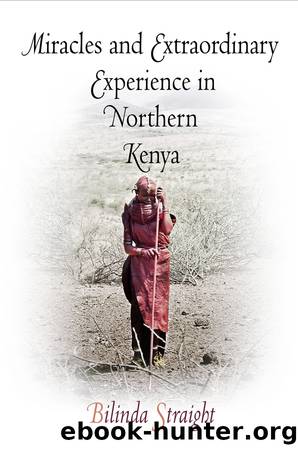Miracles and Extraordinary Experience in Northern Kenya by Bilinda Straight

Author:Bilinda Straight [Straight, Bilinda]
Language: eng
Format: epub
Tags: Social Science, Anthropology, General, Religion, Ethnic & Tribal
ISBN: 9780812209372
Google: -5HzWBsI3AYC
Publisher: University of Pennsylvania Press
Published: 2013-05-31T03:21:03+00:00
RESURRECTION FOUR: THE DISTURBING LIVES OF VAMPIRES
The European concept of the vampire is attributed to late sixteenth- and early seventeenth-century Slavic and Greek cases of people who typically had died âbadâ deaths and who returned to kill humans and animals. In order to remedy the situation, people had to behead or pierce the corpse (claimed to be resisting decay) or extract and burn its heart (which was claimed to have blood still in it) (Klaniczay 1990: 178). Alternatively, a corpse might be buried at a crossroads (as of a person dying from suicide, for example) and a stake driven through its heart to prevent it from wandering around at night (Copper 1974). Even in contemporary Inner Mani, the road continues to be a âplace of death,â and ârevenantsâ (the âwalking deadâ) are said to be met on the road (Seremetakis 1991).
As a widespread, popularized issue, vampire claims continued to surge throughout the seventeenth and into the mid-eighteenth century, spreading to Hungary and other European countries before acquiring their sexual overtones and becoming fodder for popular novels in the later eighteenth century and onward (Klaniczay 1990: 183). That transition from widespread horror to celebrated popular fiction is not coincidental and, indeed, brings me to precisely how this particular form of resurrectionâthe reanimation of putrifying corpsesârelates to Christly and saintly miracles. As it happens, this connection is not my own but, rather, one made by Catholic clerics in the 1730s who were concerned that vampires were in diabolic competition with their saints and savior. âThe vampire, like the Christian saint, was also a âvery special deadâ ⦠whose corpse resisted decay, whose grave radiated with a special light, whose fingernails and hair kept growingâlike those of several medieval saints â¦âthus demonstrating the persistence of vital energy beyond deathâ (Klaniczay 1990: 181). Klaniczay goes on to remark that vampires were thus associated with âmiraclesâ (such as the uncorrupted body), just as saints were, and, moreover, that their bloodsucking appeared as a horrifying reversal of Holy Communion. Thus, by the 1730s a debate about vampires raged that would see Catholic clerics seeking to deny vampiresâ existence and doctors seizing the opportunity to apply scientific reasoning to the problem.
Meanwhile, at the level of local experience, revenants continued to be a source of terror both before and well after the eighteenth century. In a well-documented work on the preindustrial European understandings of death and decay informing revenant accounts, Paul Barber (1988) tells the story of âThe Shoemaker of Breslau.â According to this piece of Prussian folklore, a prosperous shoemaker committed suicide in 1591 by cutting his own throat. In order to allow him a dignified burial and avoid disgrace, his widow and her sisters hired an old woman to wash and then bind the corpse so tightly that the suicide would not be apparent. Having told the community that the shoemaker had died of a stroke, the widow succeeded in seeing her husband buried in a âgreat ceremony.â Nevertheless, rumors soon spread that the shoemaker had
Download
This site does not store any files on its server. We only index and link to content provided by other sites. Please contact the content providers to delete copyright contents if any and email us, we'll remove relevant links or contents immediately.
The Four Agreements by Don Miguel Ruiz(6537)
Breaking Free by Rachel Jeffs(4113)
The Hatha Yoga Pradipika (Translated) by Svatmarama(3178)
120 Days of Sodom by Marquis de Sade(3111)
Member of the Family by Dianne Lake(2277)
The Tao of Physics by Fritjof Capra(2201)
The Psychedelic Gospels: The Secret History of Hallucinogens in Christianity by Jerry B. Brown(2092)
The Road to Jonestown by Jeff Guinn(1997)
Going Clear: Scientology, Hollywood, and the Prison of Belief by Lawrence Wright(1907)
Going Clear by Lawrence Wright(1891)
Uriel's Machine by Christopher Knight(1838)
The Grand Grimoire: The Red Dragon by Author Unknown(1731)
The Gnostic Gospel of St. Thomas by Tau Malachi(1707)
Key to the Sacred Pattern: The Untold Story of Rennes-le-Chateau by Henry Lincoln(1569)
The Malloreon: Book 02 - King of the Murgos by David Eddings(1529)
Waco by David Thibodeau & Leon Whiteson & Aviva Layton(1506)
The New World Order Book by Nick Redfern(1504)
The Secret of the Temple by John Michael Greer(1439)
Animal Speak by Ted Andrews(1413)
